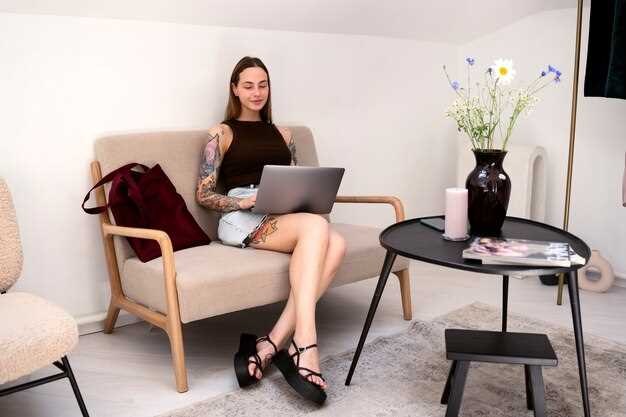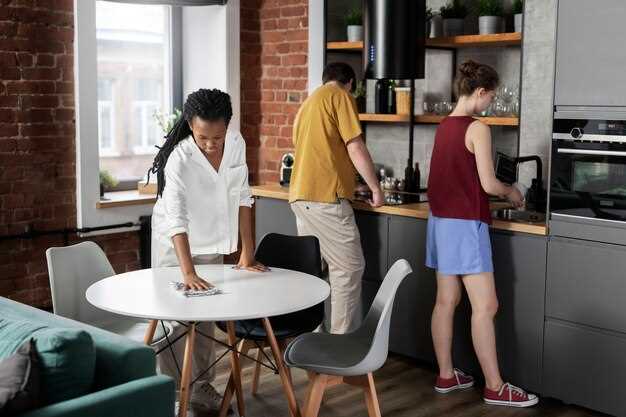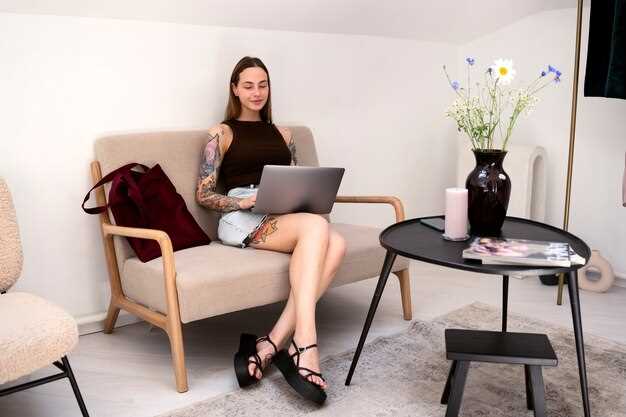Use multi-functional furniture as your first strategy for optimizing small areas. Invest in pieces like a storage ottoman or a sofa bed that serve dual purposes. This approach not only saves space but also enhances usability, allowing you to maintain a stylish yet practical environment.
Next, consider your color palette. Light, neutral shades create an illusion of more space than darker tones. Incorporate pops of color through accessories like cushions or artwork, which are easy to change and can refresh your space without overwhelming it.
Vertical space often goes underutilized, so think upwards! Install shelves on walls to display books or decor. Vertical storage solutions keep floors clear while maximizing storage. A tall bookshelf or hanging plants can add character to your room without sacrificing valuable ground space.
Mirrors serve as a fantastic design hack. Placing a mirror across from a window can reflect natural light, making your space feel larger and brighter. Choose decorative mirrors that align with your style–this subtle trick elevates both functionality and aesthetic appeal.
Finally, maintain a clutter-free environment. Invest in smart storage solutions, like under-bed storage boxes or built-in cabinets. Regularly assess what you need and keep only what you use and love, ensuring that every item in your space serves a purpose while contributing to a cohesive design.
Choosing the Right Color Palette for Small Kitchens

Opt for light, neutral shades like white, cream, or soft pastels to instantly brighten a small kitchen and create an illusion of space. These colors reflect light and make the area feel more open. Consider incorporating a few accent colors through accessories or a single feature wall to add personality without overwhelming the space.
Use monochromatic schemes to maintain a cohesive look. This approach helps streamline the design, making the kitchen feel more spacious. For example, different shades of blue or green can introduce depth and interest while remaining soothing to the eye.
Experiment with different textures and finishes. Glossy surfaces, such as high-gloss cabinets, reflect light beautifully, enhancing the brightness. Pair them with matte walls to create contrast without adding visual clutter.
Consider the principles of color temperature. Warmer tones, such as soft yellows or peach, can create an inviting atmosphere, while cooler shades like blues and greens offer a calming effect. Choose one that resonates with your cooking style and the mood you want to establish.
Implement open shelving painted in a light hue. This tricks the eye into thinking the kitchen is larger, creating a sense of airiness. Display a few decorative items to add character and break up the solid colors.
Finally, don’t shy away from darker colors for accents or small items. A dark backsplash or accessories can ground the space and add sophistication without encroaching on the overall feel of openness.
Smart Storage Solutions for Minimalist Apartments

Utilize vertical space by installing shelves that reach the ceiling. This not only draws the eye upward, creating an illusion of height, but also provides ample room for books, decor, and storage bins.
Consider multi-functional furniture such as ottomans or coffee tables with built-in storage. These items serve dual purposes while keeping your living area clutter-free.
Incorporate under-bed storage to maximize often-overlooked space. Use bins or drawers specifically designed to fit under your bed, allowing you to store extra linens, clothes, or seasonal items out of sight.
Utilize hooks and wall-mounted organizers for items like bags, coats, and accessories. This frees up floor space and keeps everyday essentials within easy reach.
Explore furniture with hidden compartments, such as sofas or benches with embedded storage. These pieces blend seamlessly with your decor while providing practical storage options.
Implement a pegboard system in your kitchen or workspace. Pegboards offer customizable storage solutions for utensils, tools, or craft supplies while adding a modern touch to your decor.
| Storage Solution | Benefits |
|---|---|
| Wall Shelves | Maximizes vertical space; serves as decor |
| Multi-functional Furniture | Combines seating and storage, reduces clutter |
| Under-bed Storage | Utilizes ignored space for seasonal items |
| Wall Hooks | Keeps items accessible; frees floor area |
| Hidden Compartment Furniture | Blends style with practicality; conceals clutter |
| Pegboard Storage | Customizable; modern aesthetic, easy access |
Optimize closet space with slim hangers and organizing bins to keep clothing neatly arranged. This helps maintain a streamlined look while making it easier to find items.
Consider a foldable desk for work-from-home situations. It provides a functional workspace without taking up valuable floor area when not in use.
Label storage containers for quick identification. This strategy saves time and helps maintain order in small spaces.
Utilizing Vertical Space in Small Living Areas

Optimize your walls to create more usable space in small areas. Tall shelves draw the eye upward and make a room feel larger. Install floating shelves to display books, plants, or your favorite decor, keeping surfaces clear.
- Use vertical storage solutions, such as tall cabinets or bookcases. Select pieces that reach the ceiling for maximum storage potential.
- Incorporate multi-functional furniture. Look for ottomans or benches with hidden storage that can fit snugly against a wall.
- Consider wall-mounted desks if workspace is needed. These can fold away when not in use, freeing up floor area.
Hang hooks or pegboards for items like bags, hats, or kitchen utensils. This keeps essentials accessible while enhancing decor.
- Display art or photos at eye level. This creates focus and interest without cluttering surfaces.
- Use tall plants to add life and draw the eye up. Place them in corners or beside furniture to heighten visual interest.
Apply light colors to vertical surfaces. This opens up the space, making it feel airier and more expansive.
By creatively putting vertical space to work, transform your small living areas into functional, stylish environments.
Incorporating Multi-Functional Furniture in Small Spaces

Choose furniture that serves more than one purpose. A sofa bed transforms a living area into a sleeping space for guests, while providing comfort during the day. Coffee tables with hidden storage allow you to keep clutter out of sight while offering a surface for drinks or books.
Consider foldable or extendable dining tables. These options can accommodate guests during meals and be compact when not in use. Folding chairs can be easily stored away and brought out only when necessary, maximizing floor space.
Look for ottomans that open up to reveal storage inside. These can act as footrests, spare seating, or even side tables. A well-chosen ottoman enhances functionality while adding style to your room.
Use modular shelving units that can be customized. These units can fit any space and adapt to changing needs. Arrange them to create a workspace, display area, or additional storage based on your requirements.
Select beds with built-in drawers or raised platforms. These maximize storage and keep bedding, clothes, or other items neatly tucked away, minimizing clutter around the room.
| Furniture Type | Functionality |
|---|---|
| Sofa Bed | Seating and Sleeping |
| Foldable Dining Table | Meals and Compact Storage |
| Storage Ottoman | Seating and Hidden Storage |
| Modular Shelving | Customizable Storage and Display |
| Storage Bed | Sleeping and Extra Storage |
Select multi-functional pieces that match your aesthetic while providing practical solutions. This approach leads to a well-organized, stylish environment, making your small space feel larger and more inviting.
Designing a Compact Yet Functional Kitchen Layout
Utilize a one-wall layout or L-shape to maximize space while maintaining workflow efficiency. Position the stove, sink, and refrigerator in a triangular formation to streamline cooking tasks. This arrangement minimizes movement and enhances functionality.
Incorporate multi-functional furniture such as a kitchen island that doubles as a dining space or provides extra storage. Open shelving can serve as both display and storage, keeping essentials within reach while avoiding bulky cabinets.
Select compact appliances designed for small spaces. Consider options like slim dishwashers, narrow refrigerators, and combination microwave-ovens. These units save space without compromising on performance.
Maximize vertical space with cabinets that reach the ceiling. Use the top shelves for infrequently accessed items. Install pull-down racks for easy access to your kitchen essentials without the need for a step stool.
Use light colors and reflective surfaces to create an illusion of a larger area. Glossy finishes on cabinets and countertops can enhance brightness and give depth to the kitchen. Task lighting under cabinets can also improve workspace visibility while adding an inviting glow.
Implement clever storage solutions, such as pull-out drawers for deep shelves, magnetic strips for knives, and corner carousels for spices. This organization helps you utilize every inch of your kitchen effectively.
| Element | Tips |
|---|---|
| Layout | Choose one-wall or L-shape to enhance workflow. |
| Furniture | Incorporate multi-functional pieces like an island. |
| Appliances | Select slim and combination models for efficiency. |
| Cabinets | Utilize ceiling height for extra storage. |
| Color scheme | Opt for light colors to create a spacious feel. |
| Storage | Implement pull-out shelves and innovative storage solutions. |
Consider modular units that allow for growth or change as your needs evolve. This flexibility helps adapt your kitchen over time without needing a complete redesign.
A compact kitchen can still shine with creativity and careful planning. Prioritize functionality while adding personal touches to reflect your style, ensuring it’s a space you enjoy cooking in.
Optimal Lighting Techniques for Limited Space
Utilize layered lighting to create depth and enhance functionality in small areas. Combine ambient, task, and accent lighting. For ambient light, opt for ceiling fixtures or wall-mounted sconces that distribute light evenly without taking up valuable floor space.
Adjustable Fixtures
Incorporate adjustable fixtures like pendant lights or floor lamps with flexible necks. These options allow you to direct light where it’s needed most, optimizing illumination while adding style. Choose dimmable options to easily adjust brightness throughout the day.
Mirrors for Reflection
Position mirrors strategically to reflect light and make a space feel larger. Place them opposite windows or light sources to amplify natural daylight. Consider using mirrored furniture or decorative elements to enhance this effect without overwhelming the area.
Open Shelving vs. Closed Cabinets: What’s Best for Your Kitchen?
Choose open shelving for a contemporary look that maximizes space. It creates an airy feel, encourages organization, and allows you to showcase decorative items. This option works well in small kitchens where closed cabinets may feel bulky. Select dishes and jars that match your style, turning everyday items into decor.
Closed cabinets, on the other hand, offer a clean, streamlined appearance and keep your kitchen looking tidy. They hide clutter and protect your items from dust and moisture. If your kitchen contains many utensils or bulk storage, consider incorporating closed cabinets to maintain a minimalist aesthetic.
Making Your Choice
Evaluate your storage needs. If you enjoy displaying beautiful dishware or collectibles, open shelving is ideal. For those who prioritize function over aesthetics, opt for closed cabinets to keep items neatly tucked away. Combining both can provide balance; use open shelves for frequently accessed items and cabinets for less-used supplies.
Maintenance and Accessibility
Open shelving requires regular dusting and organization, while closed cabinets are easier to maintain. However, open shelves offer quick accessibility, making it simple to grab items while cooking. Depending on your cooking habits, choose the option that best fits your lifestyle.
Consider the visual impact of each choice. Open shelving can make a small kitchen feel larger, while closed cabinets create a polished look. Weigh these factors carefully to choose the best solution for your kitchen space.
Room Dividers: Creating Zones in a Small Apartment
Room dividers serve as practical solutions for delineating areas within a small apartment, enhancing both functionality and aesthetics. Use these strategies to create distinctly defined spaces.
Types of Room Dividers
- Folding Screens: Lightweight and portable, folding screens easily adapt to your layout. Choose ones with interesting designs or patterns to add style.
- Shelves: Open shelving units can separate spaces while providing storage. Display decorative items or books to personalize the area.
- Plants: Tall plants like fiddle leaf figs or snake plants create natural boundaries and infuse life into your space.
- Curtains: Ceiling-mounted curtains can be drawn to temporarily separate areas, offering flexibility as needs change.
Placement Tips
- Position dividers to guide traffic flow and maximize floor space, avoiding blocking windows or natural light.
- Incorporate multi-functional furniture, like a desk or dining table, adjacent to dividers, creating seamless transitions between zones.
- Utilize color and texture contrasts in dividers to define areas without overwhelming the visual layout.
By carefully selecting and positioning room dividers, you can transform your small apartment into a harmonious blend of function and style, enhancing your living experience in every corner.
Choosing the Right Appliances for Minimalist Kitchens
Select compact appliances to maintain an open feel in your minimalist kitchen. Look for models that integrate functionality without taking up excess space. Brands increasingly offer multi-use appliances that can serve multiple purposes, such as a toaster oven that can bake and broil.
Opt for Built-in Solutions
Consider built-in appliances like dishwashers and refrigerators that blend seamlessly with cabinetry. This creates a streamlined look while maximizing functionality. Remember to measure your space carefully to ensure a perfect fit.
Energy Efficiency
Prioritize energy-efficient appliances. They not only reduce utility bills but also align with minimalist principles by promoting sustainable living. Look for Energy Star ratings to guide your choices, ensuring you select models that conserve energy without sacrificing performance.
Decorative Elements that Enhance Small Spaces
Incorporate mirrors to create an illusion of depth. Place a large mirror opposite a window to reflect light and visually expand the area. This simple addition not only brightens the room but also adds style.
Choose multifunctional furniture that doubles as decor. For instance, an ottoman that serves as a coffee table or storage can save space and enhance aesthetics. Look for pieces with unique designs that act as conversation starters.
Utilize wall art to inject personality without occupying floor space. Select a gallery wall arrangement featuring various framed pieces to add character. Consider incorporating three-dimensional art to draw the eye up and create a sense of height.
Add greenery through vertical planters or wall-mounted pots. Plants introduce life into a space while requiring minimal room. Opt for trailing varieties that cascade down, making your walls come alive.
Use rugs to define areas and add warmth. Choose a bold pattern or color that ties your space together. A well-placed rug can create a cozy nook in a small room, making it feel more inviting.
Opt for lighting fixtures that serve as decorative statements. A stylish pendant light can become a focal point while providing adequate illumination. Mix different light sources like floor lamps and sconces for a layered look.
Incorporate open shelving to display books and decor. Use shelves to showcase items that reflect your style, adding depth and interest to the walls while keeping the floor clear.
Select curtains that enhance natural light. Choose sheer fabrics that allow sunlight to filter in, making the space feel airy. Hang them higher than the window frame to give the illusion of taller ceilings.
Add vibrant colors through accessories like cushions and throws. These smaller items are easy to swap out with the seasons, allowing you to refresh the look without a full redesign.
Finally, integrate personal mementos in your decor. Displaying unique items gives your space individuality and stories to tell, enhancing the overall character of your small area.
Designing a Cohesive Look in a Multi-Purpose Room
Choose a color palette that promotes harmony across different functions. Stick to two or three complementary colors to create a seamless transition between areas. Light neutrals make spaces feel larger, while accent colors add personality without overwhelming the senses.
Opt for multifunctional furniture that complements your style. A sofa bed provides seating and sleeping space, while a coffee table with storage offers practicality without sacrificing design. Select pieces that share a consistent aesthetic, such as modern lines or rustic textures, to maintain a unified appearance.
Use area rugs to demarcate different zones while tying the overall look together. This visually distinguishes spaces, such as a living area from a workspace, all while creating a cohesive groundwork for your furnishings. Choose rugs that incorporate your color palette and design style to reinforce harmony.
Consider vertical space for decoration. Wall-mounted shelves or pegboards can display decorative items and serve functional purposes. Group items by theme or color to create a curated look that feels intentional and organized, enhancing the overall aesthetic.
Add decorative elements that reflect your personality but fit within the established theme. Artwork, cushions, and plants can tie the room together without creating visual clutter. Aim for a balance between personal touches and a curated aesthetic.
Maintain a consistent lighting scheme for a unified atmosphere. Use a combination of ambient, task, and accent lighting. Fixtures that match or complement each other in style enhance cohesion while providing practical illumination for different activities.
Finally, regularly reassess your layout. As needs change, furniture arrangements may no longer serve their purpose effectively. Stay open to fresh ideas, ensuring the space remains functional and visually appealing over time.
Tips for Maintaining a Clutter-Free Minimalist Lifestyle
Adopt the “one in, one out” rule. For every new item you bring into your home, remove an old one. This keeps your space intentional and free from unnecessary clutter.
Implement a daily decluttering routine. Spend 10-15 minutes each day tidying up specific areas. Focus on surfaces like countertops, tables, and desks to maintain a neat appearance.
Designate specific places for belongings. Assign each item a home to prevent it from lingering in random spots. This habit makes it easier to return items and reduces confusion.
Limit decorative items. Choose a few meaningful pieces that resonate with you. Ensure that each decoration adds value and enhances your space while avoiding visual overload.
Use multifunctional furniture. Opt for items like storage ottomans or coffee tables with drawers. These pieces maximize utility and keep your area organized.
Incorporate hidden storage solutions. Utilize under-bed storage boxes, built-in shelves, or other discreet areas to keep less frequently used items out of sight.
Conduct regular assessments of belongings. Set aside time every few months to evaluate what you own. Decide what you truly need and eliminate duplicates or items no longer valued.
Stay intentional with gifts. When receiving items, consider their usefulness and place in your life. Communicate with loved ones about your preference for experiences over physical gifts to minimize incoming clutter.
Educate yourself on minimalism. Read books, follow blogs, or join communities focused on minimalist living. Gaining insights from like-minded individuals can inspire and strengthen your commitment.
Prioritize quality over quantity. Invest in fewer, higher-quality items that serve a purpose and stand the test of time. This reduces the impulse to buy frequently, keeping clutter at bay.
Video:
Interior Design Tips for Small Spaces: Maximizing Functionality and Style
Interior Design Tips for Small Spaces: Maximizing Functionality and Style by Spotlyts 86 views 7 months ago 1 minute, 21 seconds
Q&A:
What are some practical tips for making a small living room feel larger?
To create the illusion of space in a small living room, consider using lighter colors on the walls and furniture, as they reflect light and can make the room appear more open. Opt for multifunctional furniture, such as a coffee table that can also serve as storage. Mirrors can be strategically placed to reflect light and create depth. Additionally, keeping the furnishings minimal and avoiding heavy drapes can contribute to a more spacious feel.
How can I maximize storage in a small kitchen without sacrificing style?
In a small kitchen, look for vertical storage solutions such as wall-mounted shelves or cabinets that extend to the ceiling. Use the inside of cabinet doors for small items or spice racks. Choose sleek, modern appliances that blend well with your decor. Incorporating open shelving can add a stylish element while being functional. Baskets and decorative boxes can also serve as both organization tools and decorative accents.
What are the best color schemes for small bedrooms to create a cozy yet spacious environment?
For small bedrooms, light and neutral colors are often the best choice, as they can help to enlarge the visual space. Soft whites, pale grays, and light beiges are excellent foundational shades. You can incorporate pops of color through bedding, artwork, or accessories to add personality without overwhelming the space. A monochromatic scheme using varying shades of a single color can also create a sophisticated look.
Are there any design tricks to make small bathrooms feel more luxurious?
To enhance the feel of luxury in a small bathroom, consider using oversized tiles for the flooring or walls, which can create a seamless look. Installing a glass shower enclosure instead of a shower curtain can also make the space feel more open. Incorporate warm lighting and high-quality fixtures to elevate the overall design. Adding plants or decorative elements like elegant towels can further enhance the ambiance and make the bathroom feel more inviting.
How can I arrange furniture in a small dining area to optimize space and comfort?
In a compact dining area, try using a round table, which can facilitate movement and provide more space than a rectangular one. Place the table against a wall or in a corner if possible. Stackable or folding chairs can be excellent choices for easy storage when not in use. Ensure there is enough room to pull the chairs out without encroaching on the pathway, maintaining a comfortable flow for guests.
What are some effective ways to make a small living room feel more spacious?
To enhance the feeling of space in a small living room, consider using light colors for walls and furnishings, as they can create an open atmosphere. Mirrors are also a great tool; placing one strategically can reflect light and give the illusion of depth. Additionally, opt for furniture that offers multifunctionality, such as ottomans with storage or a coffee table that can expand. Lastly, keeping the room clutter-free and designing a layout that promotes flow can greatly improve the sense of space.
How can I add style to a small bedroom without making it feel cramped?
Adding style to a small bedroom requires creativity while ensuring that the space remains functional. Start by choosing a cohesive color palette—soft neutrals can provide a serene backdrop, while accent colors can be introduced through pillows or artwork. Incorporate vertical storage solutions such as shelves or tall dressers to draw the eye upward. Layering textures through textiles like cozy throws and decorative rugs can add warmth without overwhelming the room. Finally, utilizing decorative lighting, such as wall sconces or string lights, can create a cozy ambiance and enhance the design without taking up valuable floor space.


